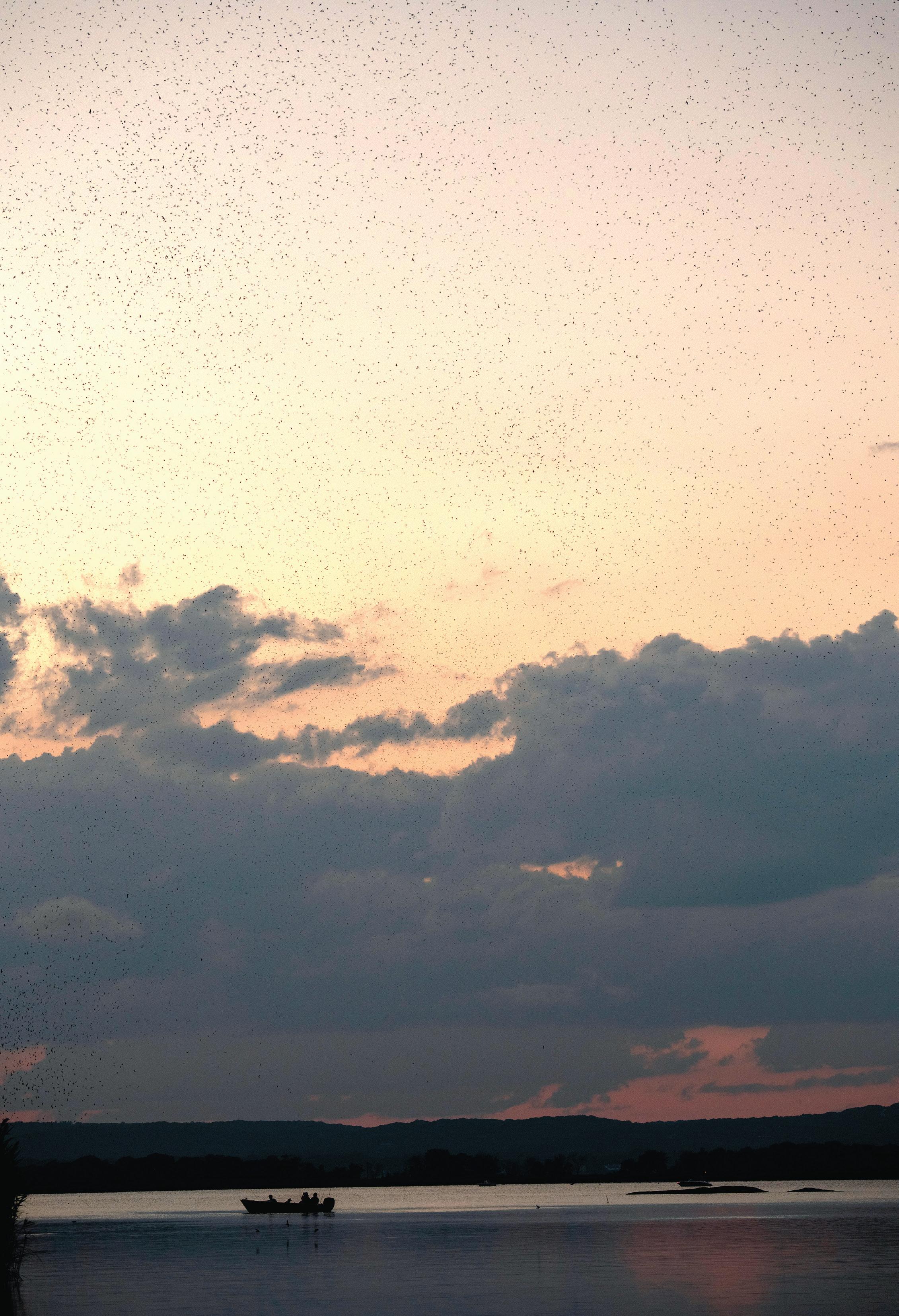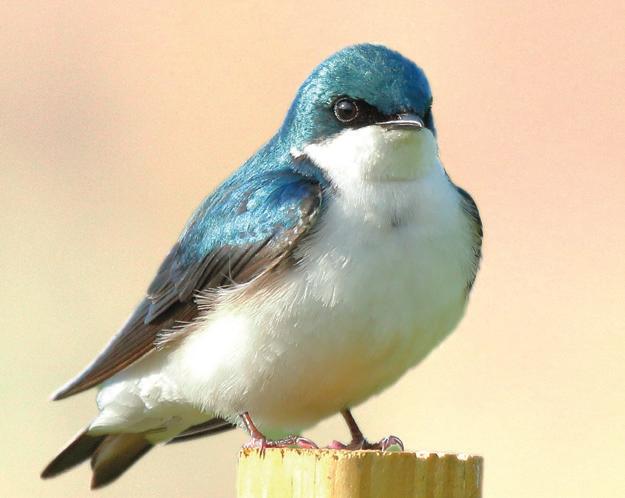
5 minute read
Swirling Swallows A Connecticut River Spectacle
By Laurie D. Morrissey Photo by Jake Koteen
With their snow-white bellies and iridescent blue-green heads, tree swallows are among our prettiest songbirds. Their aerial acrobatics make them a joy to watch as they swoop over a sunny field or play with a dropped feather during courtship.
But perhaps their most stunning feat is on stage now at the mouth of the Connecticut River. At dusk each evening over a period of several autumn weeks, tree swallows fly in from all directions, appearing as tiny black specks in the sky. Random specks swirl together to form a massive bird-cloud. Then, on some mysterious cue, they descend like a tornado into the dark reeds where they rest for the night.
This murmuration of swallows—as many as 500,000-600,000 at once—is a phenomenon that begins in late August as the birds prepare to leave the Northeast for their wintering grounds. Even for seasoned ornithologists, this staging event is remarkable.
“It is the only place to observe such a phenomenon with tree swallows that I’m aware of,” says Patrick Comins, executive director of Connecticut Audubon Society. “It is an amazing spectacle. First a few birds appear in the sky, then slowly but steadily it becomes a solid cloud of birds. At a certain point, they begin to hesitantly descend until finally the first few make it all the way down and then it’s like a torrent of birds filling the reeds.”
Even Roger Tory Peterson was impressed. “I have never witnessed a spectacle more dramatic than the twisting tornadoes of tree swallows I saw plunging from the sky after sundown,” said the famous ornithologist, who lived next to the Connecticut River and witnessed avian wonders all over the world. Like Peterson, many in Connecticut (and beyond) have become ardent observers.
Chester resident Laurian McGinley is an enthusiastic swallow watcher, making it a point to travel down the river at least once per season to catch the sight along with her family and interested friends.
“When our friends say, ‘We’re going down to see the birds,’ we know what that means: we’re taking our boats south to Old Lyme,” she says. Years ago, on her first swallow trip, theirs was among a half dozen boats. Now there may be 40 to 60 vessels, from kayaks and canoes to commercial cruise boats. “It’s spectacular,” she says. “Every night it’s different, but it’s always magical to see it. The next day, we all talk about it like we’re reviewing a play.”
The autumn spectacle is just one aspect of these fascinating birds. Because of its relative abundance and tameness, Tachycineta bicolor is among the best-studied bird species in North America. The majority of research focuses on mating and nesting behavior. Biologist Bernd Heinrich related eight seasons of observation in his book, White Feathers: The Nesting Lives of Tree Swallows. He offers an intimate look at the daily life of several pairs as they furnish their nests with white feathers “only after their eggs had been laid, not before, as per usual avian protocol.”
Besides the massive staging event at the mouth of the Connecticut River, tree swallow migration stands out for other reasons. Unlike many of their fellow insectivores, they will eat berries, allowing them to arrive early in spring to stake out their territories even before insects are active. When tree swallows depart in the fall, their pace is step by step, not straight through. Their journey along the coast to Florida and Central America takes three to four months. When not flying, they are stopping to rest, molt, refuel, and build up their energy reserves.
Cathy Malin, who conducts swallow cruises on the 64-foot RiverQuest, has more swallow spectacles under her belt than most: for 12 years, she has worked as crew member and naturalist on the boat’s six-times-a-week trips. “A lot of people are unaware of this natural event, and their first time usually finds them in awe,” she says. “For many passengers it’s an annual event not to be missed.” Her hope is that sharing the experience encourages stewardship of the river and its unique ecosystems, allowing this and other natural processes to continue.
Comins agrees. “The more people that are aware of it, the more will be interested in conserving the critical habitat of the lower Connecticut River,” he says. “Protecting migratory waystations is of critical importance. Birds need nesting wintering and migratory stopover habitat to thrive and survive. Problems with any one of the legs of that stool can upset the balance and threaten the vitality of a species.” Although phragmites—the reeds sheltering swallows in the river—are an invasive species often targeted for eradication, he says, “In general, removal is a good thing, just not on the main roosting area. I think the phragmites on the roosting islands is pretty critical and should not be messed with so long as the roost remains.” As far as the adoring fans go, Comins says they probably do not pose a threat as long as they stay off the islands.
One reason for his concern is a decline in the population of aerial insectivores, birds whose diet is almost exclusively insects captured in flight. Cornell researcher David Chang van Oordt says that scientists are struggling to figure out the specific causal link in the overall decline. He cites a combination of factors, including climate change.
“Changing precipitation patterns can dry out wetlands and make them smaller,” he says. Another factor is the decline in insect populations. “The biomass of insects is going down and there is not as much food as there used to be. Places like these are super important since the swallows need to make stops in wetlands to recharge along the way.”
Much about the tree swallow’s pre-migration “avian ballet” remains mysterious. Awed observers marvel at how such large numbers of birds flying in a mass do not bump into each other and wonder how they signal their sudden drop downward into the reeds. As with so many things in nature, there is always much more to understand.

Laurie D. Morrissey is a New Hampshirebased writer of articles, essays, and poetry. Her writing has appeared in Kearsarge Magazine, The Outside Story, and other publications.








